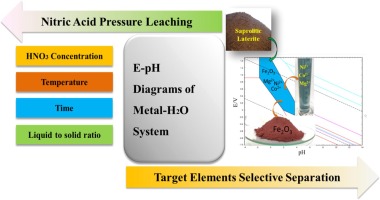当前位置:
X-MOL 学术
›
Miner. Eng.
›
论文详情
Our official English website, www.x-mol.net, welcomes your
feedback! (Note: you will need to create a separate account there.)
E-pH diagrams for the metal-water system at 150 °C: Thermodynamic analysis and application for extraction and separation of target metals from saprolitic laterite
Minerals Engineering ( IF 4.9 ) Pub Date : 2020-06-01 , DOI: 10.1016/j.mineng.2020.106365 Zhihe Cao , Baozhong Ma , Chengyan Wang , Yongqiang Chen , Bao Liu , Peng Xing , Wenjuan Zhang
Minerals Engineering ( IF 4.9 ) Pub Date : 2020-06-01 , DOI: 10.1016/j.mineng.2020.106365 Zhihe Cao , Baozhong Ma , Chengyan Wang , Yongqiang Chen , Bao Liu , Peng Xing , Wenjuan Zhang

|
Abstract Hydrometallurgical processes of laterite ores mainly occur in the aqueous solution of acid, alkali or salt. The ionization of water and change of pH are of great importance during the extraction and separation of target components. Based on the empirical equations of potential (E), pH and ionic activity terms of various species, the thermodynamics of metal-water system is summarized in the form of potential—pH (E-pH) diagrams. In the Ni + Co + Mg-H2O potential-pH diagram, the predominant area of Ni2+, Co2+ and Mg2+ is contained in the region soluble Co2+ as the pH lower than 3.8 and potential higher than −0.2 V. After superimposing the Fe-H2O potential diagram, the stable area of Ni2+, Co2+, Mg2+ and Fe2O3 is critical. The thermodynamic calculation results indicate that the extracting of Ni, Co and Mg is easy and the separation of Fe can be achieved by controlling final pH of nitric acid pressure leaching. The experiments of nitric acid pressure leaching display that more than 95% Ni and Mg and nearly 90% Co can be extracted and more than 98% Fe is separated into leach residue at initial nitric acid concentration of 120 g/L and a final pH of 0.8; leaching temperature of 150 °C; leaching time of 60 min and liquid to solid ratio of 4–8 ml/g. A new flowsheet is proposed to treat saprolitic laterite, and target components are recovered efficiently. The experimental results are in agreement with the results of the thermodynamic calculation. The process is environmentally friendly and has high economic efficiency, which can provide possibilities for commercial application of saprolitic laterite by hydrometallurgical processes.
中文翻译:

150 °C 金属-水系统的 E-pH 图:从腐泥土红土中提取和分离目标金属的热力学分析和应用
摘要 红土矿石的湿法冶金过程主要发生在酸、碱或盐的水溶液中。在目标组分的提取和分离过程中,水的电离和 pH 值的变化非常重要。基于各种物质的电位(E)、pH和离子活度项的经验方程,以电位-pH(E-pH)图的形式概括了金属-水体系的热力学。在 Ni + Co + Mg-H2O 电位-pH 图中,Ni2+、Co2+ 和 Mg2+ 的主要区域包含在可溶性 Co2+ 区域,pH 低于 3.8,电位高于 -0.2 V。叠加 Fe-H2O 后从电位图来看,Ni2+、Co2+、Mg2+ 和 Fe2O3 的稳定区很关键。热力学计算结果表明,Ni的提取,Co和Mg很容易分离,通过控制硝酸加压浸出的最终pH值可以实现Fe的分离。硝酸加压浸出实验表明,初始硝酸浓度为120 g/L,最终pH值为95%以上的Ni和Mg,接近90%的Co,98%以上的Fe分离为浸出渣。 0.8; 浸出温度150℃;浸出时间为 60 分钟,液固比为 4–8 ml/g。提出了一种新的处理腐泥土红土的流程,并有效地回收了目标组分。实验结果与热力学计算结果一致。该工艺对环境友好,经济效益高,可为湿法冶金工艺为腐泥土红土的商业化应用提供可能。
更新日期:2020-06-01
中文翻译:

150 °C 金属-水系统的 E-pH 图:从腐泥土红土中提取和分离目标金属的热力学分析和应用
摘要 红土矿石的湿法冶金过程主要发生在酸、碱或盐的水溶液中。在目标组分的提取和分离过程中,水的电离和 pH 值的变化非常重要。基于各种物质的电位(E)、pH和离子活度项的经验方程,以电位-pH(E-pH)图的形式概括了金属-水体系的热力学。在 Ni + Co + Mg-H2O 电位-pH 图中,Ni2+、Co2+ 和 Mg2+ 的主要区域包含在可溶性 Co2+ 区域,pH 低于 3.8,电位高于 -0.2 V。叠加 Fe-H2O 后从电位图来看,Ni2+、Co2+、Mg2+ 和 Fe2O3 的稳定区很关键。热力学计算结果表明,Ni的提取,Co和Mg很容易分离,通过控制硝酸加压浸出的最终pH值可以实现Fe的分离。硝酸加压浸出实验表明,初始硝酸浓度为120 g/L,最终pH值为95%以上的Ni和Mg,接近90%的Co,98%以上的Fe分离为浸出渣。 0.8; 浸出温度150℃;浸出时间为 60 分钟,液固比为 4–8 ml/g。提出了一种新的处理腐泥土红土的流程,并有效地回收了目标组分。实验结果与热力学计算结果一致。该工艺对环境友好,经济效益高,可为湿法冶金工艺为腐泥土红土的商业化应用提供可能。











































 京公网安备 11010802027423号
京公网安备 11010802027423号